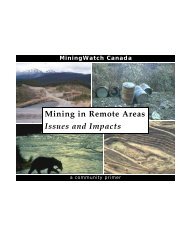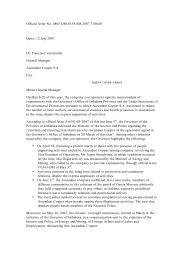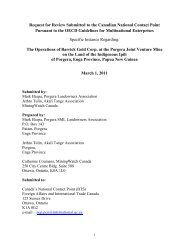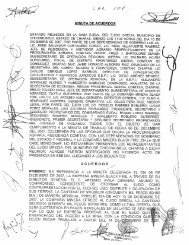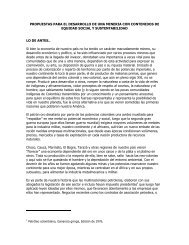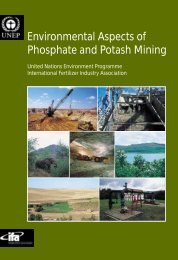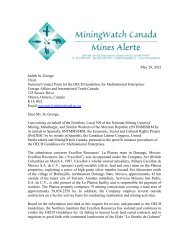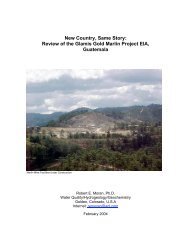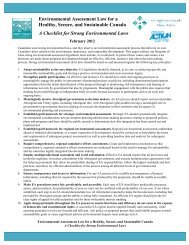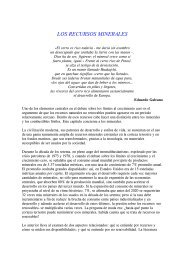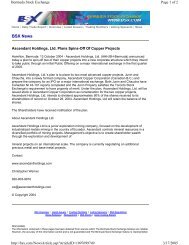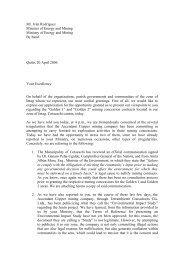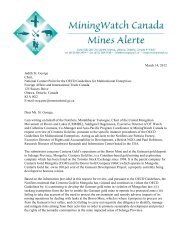TKO Investor Alert Sept 5 - MiningWatch Canada
TKO Investor Alert Sept 5 - MiningWatch Canada
TKO Investor Alert Sept 5 - MiningWatch Canada
You also want an ePaper? Increase the reach of your titles
YUMPU automatically turns print PDFs into web optimized ePapers that Google loves.
Unpacking Prosperity:<br />
Why investors should be wary about investing in Taseko Mines Ltd.<br />
A report from <strong>MiningWatch</strong> <strong>Canada</strong><br />
www.miningwatch.ca<br />
<strong>Sept</strong>ember 12, 2012<br />
Taseko Mines Limited<br />
TSX: <strong>TKO</strong><br />
NYSE Amex: TGB<br />
Taseko Mines Limited is a mid-tier mining company operating in British Columbia, <strong>Canada</strong>, with one<br />
producing mine – Gibraltar – in which it has a 75% interest. The company also has three exploration and<br />
development projects: New Prosperity, Aley Niobium and Harmony Gold. The New Prosperity Gold-<br />
Copper project, which represents 55% of the company’s reported net assets, is currently in the<br />
environmental assessment process.<br />
History of the company<br />
In 1999, Taseko purchased the Gibraltar mine from Boliden Westmin (<strong>Canada</strong>) Limited. The mine is a<br />
low-grade copper/molybdenum producer that operated under the previous owners from 1972 to 1998. Due<br />
to fluctuating copper and molybdenum prices, the mine operated sporadically. The purchase required little<br />
capital investment from Taseko [1] and the Gibraltar mine produced its first concentrate for Taseko in<br />
January, 2005. Since then, the mine has undergone a $300 million multi-phase modernization project,<br />
increasing daily milling throughput from 36,000 to 55,000 tons per day. Gibraltar is the second largest<br />
open pit copper mine in <strong>Canada</strong>.<br />
Taseko has approved a further capacity increase (GDP3) to 85,000 tpd with the construction of a new<br />
concentrator, a new molybdenum recovery facility, and mining equipment ($325 million).<br />
Commissioning is anticipated for the fourth quarter of 2012; increasing annual copper production to a<br />
capacity of 180 million pounds. The financing for this latest project has been achieved by selling 25%<br />
ownership of the subsidiary to Cariboo Copper Corporation, a Japanese consortium, and by completing a<br />
public offering of US$200 million in senior notes in April 2011. The notes are due in 2019, bearing<br />
interest at an annual rate of 7.75%. The notes are guaranteed by the Company.[2]<br />
New Prosperity Gold-Copper Project<br />
The proposed New Prosperity Project targets a large low-grade porphyry copper-gold deposit located in<br />
the Fish Lake and Fish Creek watershed 192 kilometres by road from Williams Lake, B.C. The company<br />
has held an interest in the property since 1969 but was unable to advance the project due to the economics<br />
of the low ore grades (currently averaging 0.41 g/tonne gold and 0.23% copper) and inability to obtain<br />
necessary authorizations from the federal Department of Fisheries and Oceans. With higher copper and<br />
gold prices, Taseko believes a mine would be feasible and is again attempting to gain permits to mine the<br />
deposit. The company estimates the capital costs at $1 billion.[3]<br />
1
Unpacking Prosperity: Why investors should be wary about investing in Taseko Mines Ltd. <strong>Sept</strong>ember 5, 2012<br />
An attempt to obtain environmental assessment approval for the mine was turned down by the federal<br />
government in November 2010. In February 2011, Taseko resubmitted the project with some changes<br />
under the name “New Prosperity” a final project description was filed in August 2011. A second<br />
environmental assessment is currently underway.<br />
The proposed New Prosperity Mine is on the traditional territory of the Tŝilhqot’in First Nation and the<br />
transmission line for the project will cross the traditional territories of a number of Secwepemc First<br />
Nation communities. All the affected First Nation governments as well as the Union of BC Indian Chiefs,<br />
and the Assembly of First Nations are strongly opposed to the project.<br />
Why investors should be wary of investing in this company<br />
As set out below, investors in Taseko could be exposed to a number of significant risks and uncertainties,<br />
regarding the future of the New Prosperity project that are above and beyond the risks inherent in mining<br />
projects. Despite these risks some analysts continue to make recommendations to buy Taseko based on an<br />
assumption that the New Prosperity Project will get approved.[4] Without New Prosperity this buy<br />
recommendation would change so given the uncertainties in the Project advancing we suggest that<br />
investors be very cautious. Specific risks investors or potential investors should be aware of include:<br />
1. Taseko’s New Prosperity mine continues to face major challenges in obtaining necessary<br />
environmental approvals;<br />
2. The New Prosperity Project does not have and is unlikely to get a social licence to operate from the<br />
affected First Nations communities and Aboriginal governments;<br />
3. The New Prosperity capital and operating cost estimates do not include key factors that will affect the<br />
economic viability of the project and share price volatility is likely to continue;<br />
4. Political support from provincial and federal governments for the New Prosperity Project is uncertain;<br />
5. The fierce opposition to this project from Aboriginal peoples and environmental organizations may<br />
result in extensive litigation and may have implications for the future of other extraction projects in<br />
BC;<br />
These points are elaborated below.<br />
<strong>MiningWatch</strong> <strong>Canada</strong> Page 2
Unpacking Prosperity: Why investors should be wary about investing in Taseko Mines Ltd. <strong>Sept</strong>ember 5, 2012<br />
1. The New Prosperity Project continues to face major challenges in obtaining necessary<br />
environmental approvals<br />
Federal approval to proceed with the New Prosperity Project would require authorizations under the<br />
Fisheries Act, a permit under the Navigable Waters Protection Act and a licence under the Explosives Act.<br />
Prior to these approvals the project must be reviewed and approved under a federal environmental<br />
assessment as per the Canadian Environmental Assessment Act 2012.<br />
In November 2010, the federal government rejected the Prosperity Project based on the findings of an<br />
independent review panel.[5] The Panel concluded that: “the Project would result in significant adverse<br />
environmental effects on fish and fish habitat, on navigation, on the current use of lands and resources for<br />
traditional purposes by First Nations and on cultural heritage, and on certain potential or established<br />
Aboriginal rights or title. The Panel also concludes that the Project, in combination with past, present and<br />
reasonably foreseeable future projects would result in a significant adverse cumulative effect on grizzly<br />
bears in the South Chilcotin region and on fish and fish habitat.”[6]<br />
The federal government suggested that Taseko could re-submit the project, if it were able to address the<br />
issues identified in the panel report. In February 2011, Taseko submitted a revised project description that<br />
the company claims addressed the Panel concerns. The new mine plan situates the tailings impoundment<br />
further upstream, does not include the draining of Fish Lake, and establishes an alternative site for the<br />
waste rock and overburden. This mine plan was included in the Alternatives Assessment done by Taseko<br />
for the previous environmental assessment. The review panel concluded then that this plan would not<br />
mitigate the identified impacts. [7]<br />
The federal review panel concluded that the mine plan alternative now proposed as the<br />
New Prosperity Project would not mitigate the significant negative effects it identified<br />
with the initial plan, including the impacts to Fish Lake.<br />
(Ramsey Hart, <strong>MiningWatch</strong> <strong>Canada</strong>)<br />
<strong>MiningWatch</strong> <strong>Canada</strong> Page 3
Unpacking Prosperity: Why investors should be wary about investing in Taseko Mines Ltd. <strong>Sept</strong>ember 5, 2012<br />
The level of concern regarding the project within the federal bureaucracy seems to have been heightened<br />
through the first review process. During the Review Panel process for the previous application the<br />
Department of Fisheries and Oceans (DFO) focused it’s concerns on the immediate impacts of the project<br />
on the fish habitat in the immediate area of the mine site. In a letter from November 2011 to CEAA the<br />
DFO indicated it was also concerned about potential down-stream impacts on the salmon populations in<br />
the Taseko and Chilcotin Rivers.[8]<br />
On June 8, 2012, Taseko submitted a draft Environmental Impact Statement to the federal government<br />
based on this plan. Lisa Walls, the Director of the Canadian Assessment Agency for the Pacific and<br />
Yukon region wrote that the EIS “did not meet the requirements of the EIS guidelines” and that “There is<br />
substantial information missing from this draft EIS. The quality of all figures in the draft EIS is very<br />
poor.”[9] The mainstream press has reported on the company’s failure, including articles by the Canadian<br />
Press and Postmedia News.[10]<br />
Tŝilhqot’in Nation Tribal Chair Chief Joe Alphonse said “the scathing review” [...] “comes as no surprise<br />
for us… We have said all along that there was no way this plan could work”. Xeni Gwet’in Chief Marilyn<br />
Baptiste said, “This is the same company that stated over and over during the original hearings that its<br />
preferred plan was environmentally superior to the other two options; that the mine could not be built<br />
without destroying Teztan Biny [Fish Lake], and then changed its tune as soon as that original plan was<br />
emphatically rejected by the Federal Government. This explains to us why they could not develop a<br />
respectable new EIS.” [11]<br />
2. The New Prosperity Project does not have and is unlikely to get a social licence to<br />
operate from the affected Aboriginal governments and communities<br />
The Xeni Gwet’in, the Tŝilhqot’in band upon whose traditional territory the mine is proposed, have been<br />
in court a number of times to gain recognition of their title and Aboriginal rights. In November 2007,<br />
Justice David Vickers of the British Columbia Supreme Court ruled that the Tŝilhqot’in (Chilcotin)<br />
people have proven Aboriginal title in the vicinity of the New Prosperity Project (though not where the<br />
actual Project is located) and Aboriginal hunting, trapping and trade rights throughout lands including the<br />
Project area. Although Justice Vickers declined to make a declaration of title based on technical issues, he<br />
found that the tests for evidence of title were met in almost half the area claimed (approximately 200,000<br />
square hectares). The case was appealed by all parties and on June 27, 2012, the BC Court of Appeal<br />
upheld Justice Vickers’ ruling on Aboriginal rights. The ruling did fall short of giving title to the Xeni<br />
Gwet’in, however, and the Band is now seeking leave to appeal to the Supreme Court.<br />
Despite years of effort, the mine developer, Taseko Mines, has not obtained consent from the affected<br />
First Nations for this project. The Tŝilhqot’in National Government opposes the project, and has been<br />
engaged in various forms of resistance to the project, from legal challenges, government-to-government<br />
lobbying, public relations campaigning, and increasingly direct actions such as protests at Taseko’s<br />
annual general meeting and blocking exploration equipment from accessing the proposed mine site.<br />
Across <strong>Canada</strong>, especially in BC, environmental groups have rallied to support the Tŝilhqot’in and<br />
Secwepemc in their opposition to the mine. Even in Williams Lake, a forestry town that might be<br />
expected to support the project, many citizens have banded together in opposition, forming the Fish Lake<br />
Alliance.<br />
<strong>MiningWatch</strong> <strong>Canada</strong> Page 4
Unpacking Prosperity: Why investors should be wary about investing in Taseko Mines Ltd. <strong>Sept</strong>ember 5, 2012<br />
The company’s response to its critics has not been conciliatory. In March 2012, it took the Western<br />
<strong>Canada</strong> Wilderness Committee to court for defamation. Previously, in November 2011, Taseko CEO<br />
Russell Hallbauer wrote to the Canadian Environmental Assessment Agency giving his opinion on how<br />
“to ensure the panel appears fair and balanced”. His suggestions included:<br />
• Not appointing an aboriginal member to the Canadian Environmental Assessment Agency<br />
review panel.<br />
• Not starting hearings with drumming or aboriginal prayer ceremonies, something Taseko says<br />
is inappropriate.<br />
• Not considering spirituality of a place as an aboriginal right.<br />
This letter further inflamed opposition to the project and created a storm of media interest.[12]<br />
In 2010 the socially responsible investing group Ethical Funds excluded Taseko Mines from its portfolios<br />
“due to environmental, social and governance (ESG) risk.”[13]<br />
Tsilhqot’in Chiefs, community members and allies hold a demonstration at Taseko’s 2012<br />
AGM (Sue Smitten, Raven Trust)<br />
<strong>MiningWatch</strong> <strong>Canada</strong> Page 5
Unpacking Prosperity: Why investors should be wary about investing in Taseko Mines Ltd. <strong>Sept</strong>ember 5, 2012<br />
3. The New Prosperity capital and operating cost estimates do not include key factors<br />
that will affect the economic viability of the Project and share price volatility is likely to<br />
continue<br />
A soon-to-be published risk analysis of the economics of the New Prosperity Project undertaken by<br />
mining analyst Joan Kuyek for the Tŝilhqot’in National Government[14] found the following:<br />
●<br />
●<br />
The economics of the mine are questionable. It is a very low grade ore body, with reserves of 0.41gpt<br />
for gold and 0.23% copper[15]. This makes it the lowest grade copper mine in <strong>Canada</strong> and one of the<br />
lowest grade mines in the world. For the most part the gold is dispersed throughout the copper and<br />
will depend on good returns from copper to make it economic to mine. There are areas within the<br />
projected open pit that have very little mineable ore. During years 8-11 of operations, when those<br />
rocks have to be mined,[16] there is a serious risk that the mine will close. The increased reserves and<br />
resources and the longer mine life announced in 2010 are based on increased commodity prices for<br />
gold and copper, not on the discovery of more ore. The basic outline of the deposit has not changed<br />
since 1998, when the last exploratory drilling was done.<br />
Kuyek’s review of the filed technical reports for 2007 and 2009 also reveals these problems with the<br />
proposed mine’s economics:<br />
○<br />
○<br />
○<br />
○<br />
The 2007 and 2009 mine cost estimates make no allowance for financing costs, federal or<br />
provincial income tax and sales tax, or compensation to affected First Nations.[17] The Gibraltar<br />
mine expansion has to pay a 7.75% interest rate for its borrowing[18]; but the 2009 Technical<br />
report assumes no financing costs or interest for the new mine.<br />
The reserve and resource estimates are based on a US-Cdn exchange rate of $0.82, when it has<br />
been closer to par for a number of years now. The 2009 Technical Report states: “the reserve is<br />
most sensitive to the exchange rate, followed by operating cost and metal prices.”[19]<br />
A comparison of the 2007 and 2009 Technical Report Net Smelter Return Calculations in table<br />
17-5 reveals that the 2009 report used lower estimates for treatment and refining charges than the<br />
2007 one and lower estimated penalties for contaminants: antimony, arsenic and mercury. No<br />
explanation is given for this anomaly.<br />
The company will have difficulty finding markets for its product. The 2009 Report states: “this<br />
low copper means that there will probably be some limit on the quantity that any one smelter will<br />
take as grade is below the average smelter blend and reduces the metal output from the furnaces.<br />
A consideration with Prosperity concentrate is the levels of arsenic, antimony and mercury when<br />
taken together... in summary Prosperity concentrate will find a market but the prospective<br />
quantity of about 200,000 tons per annum and given the penalty considerations will likely need to<br />
be spread around a number of smelters.” [20]<br />
●<br />
Taseko has signed a deal with Franco-Nevada for a loan of $350 million for construction of the New<br />
Prosperity Project, in return for a promise to sell 22% of the gold it produces to Franco-Nevada for<br />
$400/oz. Any difference between this fixed price and the spot price of gold will go toward paying off<br />
the loan. Franco-Nevada’s concerns about the mine’s economic viability are evident from the<br />
conditions of the loan. Before the money is released Taseko has to secure all the capital funding for<br />
the mine, meet benchmarks for construction set by Franco-Nevada, and secure market arrangements<br />
for the majority of the concentrate[21]. The reduced income from the fixed price for 22% of the gold<br />
is not reflected in the company feasibility study..<br />
<strong>MiningWatch</strong> <strong>Canada</strong> Page 6
Unpacking Prosperity: Why investors should be wary about investing in Taseko Mines Ltd. <strong>Sept</strong>ember 5, 2012<br />
●<br />
●<br />
Increased capital and operating costs since 2009 have not been taken into account. In the most recent<br />
filings from Taseko, it is clear that Gibraltar has suffered not only from cost increases, but from<br />
volatile copper prices.[22] An indication of rising capital costs can be seen at the nearby Mt. Milligan<br />
mine which is facing a $300 million cost over-run for start-up.<br />
To overcome the objections of the earlier environmental assessment to the mine, Taseko is currently<br />
proposing to build and operate a tailings storage facility that it had previously argued was completely<br />
uneconomic and carried a higher environmental risk. During the 2009 environmental assessment,<br />
Taseko argued that the only economically possible alternative for tailings disposal was to drain Fish<br />
Lake to build waste storage piles, and to build the tailings dump at the south end of the lake. The new<br />
plan proposes to move the tailings dump 2 kilometres upstream. The extra $300 million cost cited by<br />
the company does not include mitigation of the environmental impacts, but rather is for the<br />
construction and operating costs of locating the waste rock pile further away.[23] There has been no<br />
revised technical report that incorporates increased construction and operating costs. There has been<br />
no accounting of the extra mitigation costs such as water treatment.<br />
Taseko continues to maintain the New Prosperity project as an important asset on their books,<br />
representing 55% of the net value of the company. Should the project not be approved Taseko will be<br />
forced to write down its investment in this project, which it has stated is approximately $110-million. [24]<br />
This would not be the first time that a Canadian mining company has had to write-down a significant<br />
amount after failing to obtain a social licence. Other recent significant loses include[25]:<br />
• 2003: Manhattan Minerals - Tambogrande, Peru (write down of US$ 59.3 million)<br />
• 2005: Meridian Gold (now Yamana) - Esquel, Argentina (write down of US $542.8 million)<br />
• 2007: Northgate Minerals - Kemess North, BC (write down of US $31.4 million)<br />
As of its June 2012 AGM, Taseko had a net cash position of $118-million.[26] With a preliminary capital<br />
cost estimate of $1-billion, the New Prosperity project would require substantial new external investments<br />
in addition to those already secured. Given the potential for ongoing opposition and potential for delays in<br />
advancing the project, Taseko will have a challenge to raise the necessary capital to build the project.<br />
Major investors are unlikely to associate themselves with a risky project that would put both their<br />
investment and their reputation at risk. As stated above, at a minimum Taseko will not have access to<br />
investors that follow an ethical investing approach. The pursuit of the New Prosperity project could also<br />
be seen as contradicting social responsibility and sustainability norms that are increasingly being adopted<br />
by major lenders.<br />
Taseko stock prices have shown considerable volatility in recent years. This volatility has, in part, been<br />
related to its persistence in pursuing the controversial Prosperity project. When the federal Review Panel<br />
Report was released in July 2010, and when the Canadian government rejected the mine proposal in<br />
November 2010 Taseko’s stock price sharply declined. As shown below, the stock price dropped from<br />
approximately $6.50 to $4.50 shortly after the government’s decision. The first rejection was not the only<br />
time that share prices of the company plunged. An earlier drop lead to speculation about a possible leak of<br />
information about the federal decision on Prosperity[27]. Another drop was prompted by news that<br />
Taseko failed to gain a court injunction to allow it access to the Prosperity site in the face of the<br />
Tŝilhqot’in objecting to the work occurring without consultation.[28] On <strong>Sept</strong>ember 4, 2012, the stock<br />
price was only $2.96.<br />
<strong>MiningWatch</strong> <strong>Canada</strong> Page 7
Unpacking Prosperity: Why investors should be wary about investing in Taseko Mines Ltd. <strong>Sept</strong>ember 5, 2012<br />
Five year stock chart for Taseko (TSX) with arrows indicating price declines related to the<br />
company’s pursuit of the Prosperity project. (Adapted from a Stockhouse.com chart)<br />
4. Political support for the Project is uncertain<br />
It is unlikely that the company will find a way to address the long list of environmental and Aboriginal<br />
rights issues associated with the Project so approval can only come with political support that overrides<br />
the ongoing controversy and potentially negative findings of the second Review Panel.<br />
Although the current BC provincial Liberal government has been supportive of the Prosperity/New<br />
Prosperity project, the continuance of this political support is far from certain. The BC NDP have<br />
opposed the project because of the strong objections of the affected First Nations[29]. Recent polls have<br />
the NDP showing a comfortable lead over the Liberals heading towards an election in May 2013.[30]<br />
At the federal level, the Conservative government has been vocal in its support for other resource<br />
development projects but has remained relatively silent on the New Prosperity project. In response to the<br />
the inadequate draft Environmental Impact Statement submitted to the Canadian Environmental<br />
Assessment Agency, Environment Minister Peter Kent’s press secretary issued a statement, saying that<br />
“Our government has always insisted on environmental reviews that are thorough, rigorous and<br />
completed in a timely fashion,” and that “As Taseko learned the first time around, our government will<br />
only approve projects that are deemed environmentally sound.”[31] This is not the kind of unambiguous<br />
support that other controversial projects have received from the federal government.<br />
At this time there is no indication that the federal government is willing to further damage its credibility<br />
on environmental and science based decision making by approving this project should the Review Panel<br />
find once again that the project has “significant environmental effects that cannot be mitigated’.<br />
<strong>MiningWatch</strong> <strong>Canada</strong> Page 8
Unpacking Prosperity: Why investors should be wary about investing in Taseko Mines Ltd. <strong>Sept</strong>ember 5, 2012<br />
5. The fierce opposition to this project from Aboriginal peoples and environmental<br />
organizations may result in extensive litigation and may have implications for the future<br />
of other resource extraction projects in BC.<br />
The battle over the New Prosperity Project may be a catalyst equal to Enbridge’s Northern Gateway<br />
pipeline in inflaming conflict between First Nations and resource extraction companies. Case law<br />
acknowledges the importance of the “honour of the Crown”, “fiduciary responsibility” and the “duty to<br />
consult and accommodate” which will be difficult to reconcile with a decision to approve the New<br />
Prosperity Project. The duty owed by the Crown is in proportion to the potential impacts and strength of<br />
the Aboriginal claim of rights or title. With the New Prosperity both the impacts, as demonstrated through<br />
the previous Review Panel report and the strength of claim as demonstrated through the Williams Case<br />
are considerable, placing this project on the far end of the spectrum of duty. Some analysts interpret the<br />
Supreme Court’s Haida decision as indicating that under such circumstances there the government must<br />
gain the consent of the affected Aboriginal people for a project to move forward.[32] Given the above,<br />
should the federal government give approval to the project we would anticipate legal action based on a<br />
failure to meaningfully accommodate the affected First Nations.<br />
The Project may also become the legal battlefield where recent changes to the Canadian Environmental<br />
Assessment Act and the Fisheries Act contained within Bill C-38 are confronted by BC First Nations.<br />
Lack of Aboriginal consultation regarding the changes and the nature of the changes have drawn sharp<br />
criticism from First Nations, including the Union of BC Indian Chiefs.[33] The New Prosperity project<br />
could serve as a lightning rod for litigation on the failure of government to meet the duty to consult and<br />
accommodate on legislation that has profound impacts on Aboriginal peoples.<br />
Xeni Gwet’in Chief Marilyn Baptiste speaks at a rally opposing the New Prosperity<br />
Project. (Sue Smitten, Raven Trust)<br />
<strong>MiningWatch</strong> <strong>Canada</strong> Page 9
Unpacking Prosperity: Why investors should be wary about investing in Taseko Mines Ltd. <strong>Sept</strong>ember 5, 2012<br />
NOTES AND REFERENCES<br />
[1] Taseko received the mine, all mineral interests, mining and processing equipment and facilities, and<br />
assumed responsibility for ongoing reclamation. Pursuant to the terms of the acquisition, Taseko acquired<br />
mining equipment, parts and supplies inventories valued at $19 million, an existing British Columbia<br />
Government environmental deposit of $8 million, and mineral interests valued at $3.3 million, and<br />
received $20.1 million in cash over 18 months from closing, of which $17 million was received pursuant<br />
to a 10-year non-interest bearing convertible debenture issued to Boliden. Taseko subsidiary Gibraltar<br />
assumed the estimated reclamation liability pertaining to the mine of $32.7 million. The principal sum<br />
advanced under the debenture was convertible into Taseko common shares in the first year at $3.14 per<br />
Taseko share.<br />
[2] Taseko Mines News Releases from March 24, 2010; April 15, 2011; and July 27 2012:<br />
http://www.tasekomines.com/news/releases/IDYR2012<br />
[3] Taseko Mines Ltd. New Propserity Project Description, August 2011:<br />
http://www.newprosperityproject.ca/wp-content/themes/prosperity/images/project-description.pdf<br />
[4] TD Securities, July 10 2012, Action Notes: Taseko Mines Ltd.<br />
[5] Report of the Federal Prosperity Review Panel, July 2, 2010: http://www.ceaaacee.gc.ca/050/documents/46911/46911E.pdf<br />
[6] Ibid.<br />
[7] Ibid.<br />
[8] Letter of Comment from Fisheries and Oceans <strong>Canada</strong>, November 2, 2011:<br />
http://www.ceaa.gc.ca/050/documents/53302/53302E.pdf<br />
[9] Letter and Table of Comments from the Canadian Environmental Assessment Agency to Taseko<br />
Regarding the Review of the Draft Environmental Impact Statement, July 6, 2012:<br />
http://www.ceaa.gc.ca/050/documents/p63928/80180E.pdf<br />
[10] Canadian Press, July 17, 2012. “Federal agency finds holes in Taseko mine’s draft environmental<br />
report”. http://www.brandonsun.com/lifestyles/breaking-news/federal-agency-finds-holes-in-tasekomines-draft-environmental-report-162758206.html?thx=y<br />
and Postmedia News, July 16, 2012. “B.C.<br />
Junior miner accused of making “misleading” statement to federal agency”.<br />
http://www.canada.com/technology/junior+miner+accused+making+misleading+statement+federal+agen<br />
cy/6942155/story.html<br />
[11] Tŝilhqot’in National Government, July 17, 2012. “CEAA Slams Document for Missing Information,<br />
Inaccuracies, Confusing Format, and Poor Work”. http://www.raventrust.com/blog/2012-07/tasekomines-146-draft-environmental-impact-statement-proves-issues-are-not-being-addressed.html<br />
[12] Vancouver Sun, May 1, 2012. “Taseko aims to ban prayers at hearings, Children’s plays also<br />
targeted”.<br />
http://www.vancouversun.com/Taseko+aims+prayers+hearings/6545066/story.html#ixzz23ABPtdwQ<br />
Canadian Press, May 2, 2012.; “Taseko Mines: First Nations Input On Prosperity Mine Should Be<br />
Limited”. http://www.huffingtonpost.ca/2012/05/01/taseko-mines-first-nations_n_1469068.html<br />
<strong>MiningWatch</strong> <strong>Canada</strong> Page 10
Unpacking Prosperity: Why investors should be wary about investing in Taseko Mines Ltd. <strong>Sept</strong>ember 5, 2012<br />
Tŝilhqot’in National Government, Local MLA Bob Simpson. 100 Mile House Free Press, May 9, 2012.<br />
“Taseko letter to Kent offends First Nations”. http://www.bobsimpsonmla.ca/taseko-letter-to-kentoffends-first-nations/<br />
[13] Ethical Funds in Action. “Sifting Through the Risks: Taseko Mines”. June 2010:<br />
http://www.ethicalfunds.com/NEIFiles/PDFs/5.1.4%20Sustainable%20Investing%20Update/Ethical%20<br />
Funds%20in%20Action%202011/Ethical_06_11_En_web.html<br />
[14] J. Kuyek. Pitfalls or Promises:A risk analysis of the economics of the TML Mine proposal. August<br />
2012: http://www.ceaa.gc.ca/050/documents-eng.cfm?evaluation=63928<br />
[15] TML. Annual Information Form. March 2012, page 25, Table 6. Reserves on the basis of $1.65/lb<br />
Cu and $650/oz Au. at a $5.50/lb NSR pit-rim cut-off.<br />
[16] Jones, Technical Report 2009, Table 18-19, page 154.<br />
[17] Jones, Technical Report 2009, page 153.<br />
[18] TML. Management Discussion and Analysis, March 2012, page 9.<br />
[19] Jones, Technical Report 2009, page 155.<br />
[20] Jones, Technical Report 2009, page 125-126.<br />
[21] TML. Amended Short Form Prospectus, April 4, 2011, page 11.<br />
[22] TML, Management Discussion and Analysis. March 2012, page 9.<br />
[23] TML, Project Description, August 2011, page 4.<br />
[24] Taseko Mines, New Prosperity website: http://www.newprosperityproject.ca/projectdescription/meet-taseko<br />
[25] Michael Jantzi. “Responsible Investing for Institutional <strong>Investor</strong>s”. Presentation to Canadian Institute<br />
of Actuaries. Nov. 2011:<br />
http://www.actuaries.ca/meetings/investment_seminar/2011/Session_2_Michael_Jantzi.pdf<br />
[26] Taseko Mines 2012 AGM Presentation, online:<br />
http://www.tasekomines.com/workspace/media/mce/presentations/June_2012_AGM.web.pdf<br />
[27] CBC News, Nov. 25, 2010. “Possible Ottawa role in stock sell-off probed”.<br />
http://www.cbc.ca/news/canada/story/2010/11/24/f-greg-weston-taseko.html<br />
[28] Stockhouse, Dec. 5, 2011. “Uncertainty Hits Taseko Stock Value”<br />
http://www.stockhouse.com/cmspages/handler404.aspx?404;http://www.stockhouse.com:80/communitynews/2011/dec/5/uncertainty-hits-taseko-stock-value<br />
[29] The Rush, May 12, 2012. “Wyse unimpressed with Taseko’s request”<br />
http://www.therushfm.ca/news_and_sports/news/Local/12/05/7/WYSE-UNIMPRESSED-WITH-<br />
TASEKO-S-REQUEST and<br />
<strong>MiningWatch</strong> <strong>Canada</strong> Page 11
Unpacking Prosperity: Why investors should be wary about investing in Taseko Mines Ltd. <strong>Sept</strong>ember 5, 2012<br />
Ottawa Citizen, May 11, 2012. “B.C. NDP leader Dix predicts ‘businesslike’ relations with Ottawa”<br />
http://www.ottawacitizen.com/touch/technology/leader+predicts+businesslike+relations+with+Ottawa/66<br />
08787/story.html?rel=835859)<br />
[30] CBC. July 10 2012. “Dix, NDP maintain solid lead in B.C. poll”<br />
http://www.cbc.ca/news/canada/british-columbia/story/2012/07/10/bc-angus-reid-poll.html<br />
Globe and Mail, July 16, 2012. “B.C. NDP Leader Adrian Dix says he can work with Harper”<br />
http://www.theglobeandmail.com/news/british-columbia/bc-ndp-leader-adrian-dix-says-he-can-workwith-harper/article4421638/?cmpid=rss1<br />
[31] The Canadian Press. “Federal Agency Finds Holes in Taseko Mine’s Draft Environmental Report”<br />
July 17, 2012: http://www.winnipegfreepress.com/arts-and-life/life/greenpage/federal-agency-finds-holesin-taseko-mines-draft-environmental-report-162758206.html<br />
[32] Reconciliation Project, Dec. 5, 2011. “Do First Nations have a veto over development?”<br />
http://reconciliationproject.ca/2011/12/05/do-first-nations-have-a-veto-over-development/<br />
Grand Council of the Cree, Nov. 18, 2004. “Haida Nation v. British Columbia (Minister of Forests)”<br />
http://www.gcc.ca/archive/article.php?id=207<br />
[33] Union of BC Indian Chiefs, June 12, 2012. “OPEN LETTER: Union of BC Indian Chiefs’<br />
Opposition to Bill C-380”<br />
http://www.ubcic.bc.ca/News_Releases/UBCICNews06121201.html#axzz216CQV6cF<br />
<strong>MiningWatch</strong> <strong>Canada</strong> Page 12



